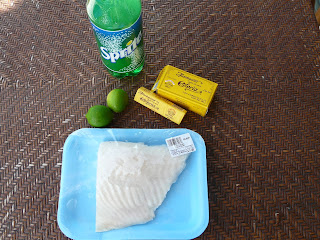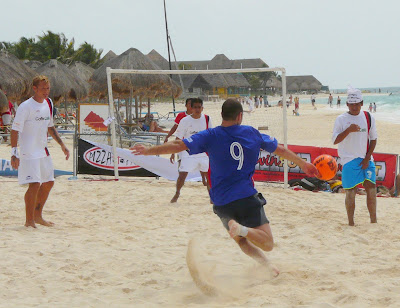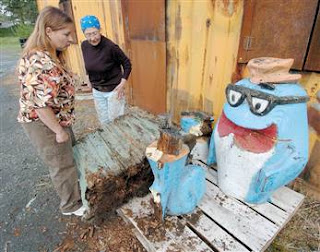Mrs. Princess and I went shopping the other day at Walmart (yes we have a Walmart) and as we passed through the seafood department I noticed some big pieces of fish laid out on ice that looked strangely familiar to me but somehow out of place here in Playa del Carmen. Upon closer inspection and reading the sign stuck in the ice I realized I was looking at Alaskan halibut. Being from the Pacific Northwest and great lovers of halibut, Mrs. Princess and I agreed that because it was just such a rare find we would have to purchase some no matter the cost. The halibut pieces were big boneless skinless filets and still frozen. There were a couple of pieces up front that had thawed out and I gave them the old sniff test. Mrs. Princess who wasn’t about to trust my nose gave them the once over herself. “Buy it” she then hastily commanded while pointing at some of the frozen pieces.

Back in Oregon we would pay anywhere from $7.00 a pound to as much as $15.00 per pound for halibut that was practically caught in our own backyard. Well, if there was halibut from Alaska in Playa, we were going to have some and that was that, cost be damned.
I approached the fishmonger and mentally prepared myself for the culinary sacrifices we would need to make in the coming days for the opportunity this rare treat was going to provide us that night however, nothing could have prepared me for the answer I received from the fishmonger. Our conversation was in Spanish so it always takes my mind a few extra seconds to process even simple Spanish conversation. I was promptly informed that the price of the Alaskan halibut was 48 pesos. My mind became a jumbled mass as it tried desperately to decipher what my ears had just heard. “Forty eight pesos” I blurted out. “Why…that’s ridiculous!” I said, which it was, although I only said it because my brain was still trying to figure out how much “cuarenta y ocho pesos” actually was. Once I got my arms around the 48 peso price tag the next step was to find out just how much halibut I would get for 48 pesos which is the US equivalent of about $4.50.
I knew that this was where I was going to get sucker punched and find that 48 pesos was going to buy me a piece of halibut slightly smaller in size than a US one dollar bill. Okay here goes “How much halibut do I get for 48 pesos?” “One kilo” replied the fishmonger. Luckily Mrs. Princess was standing behind me and grabbed me as I stumbled backwards nearly overturning the seafood display table behind me.
I quickly regained my composure and ran the math. At 48 pesos per kilo I would be paying just a few pennies over $2.00 a pound for boneless skinless Alaskan halibut filets. Suddenly I heard myself blurting to the fishmonger “We’ll take everything you’ve got.” The fishmonger nodded appreciatively if not somewhat surprisedly and opened the large door to the freezer just behind him. Just inside was a large unopened box about 4 feet square and 4 feet high. He pried the lid from the box exposing what appeared to me at the time to be all of the frozen halibut that could have come out of Alaska in the last sixty days. I told Mrs. Princess to stay with the fishmonger and to keep a close eye on him. I didn’t want to take any chance of messing this up. She asked where I thought I was going and I said “Over to the appliance department to look at freezers!”
Over in the freezer department I found that I would need to purchase at least two very large freezers to hold all the halibut that we were going to buy. Suddenly, the old brain came out of shock and began functioning partially again which is about as much as I can ask of it even on a good day. I could hear it whispering to me “Mike, your losing it. Go back to the fish counter, buy some halibut and go home and have a nice dinner with Ima Princess.” Dejectedly but with the satisfaction that the day was not totally lost, I proceeded back to the counter and explained to Mrs. Princess and the kindly fishmonger that we would not, after all be buying all of the beautiful, boneless, skinless, flash frozen, Alaskan halibut filets that Walmart had to offer. Strangely enough they both took it rather well.
After loading up with three or four large packages of halibut we headed home with our catch of the day. For the next three days, we would eat halibut at night and I would go back to Walmart early the next morning to buy even more packages of halibut. The first two days went well but on the third, the fishmonger's freezer was bare. No more beautiful, boneless, skinless, flash frozen, Alaskan halibut filets. Knowing that I still had a goodly supply at home in the freezer made me happy and knowing that Walmart didn’t have any more for me to buy and bring home made Mrs. Princess happy. I guess it was a win, win. I didn’t tell Mrs. Princess that the fishmonger told me they would have more soon.

Needless to say we’ve been eating a lot of halibut prepared in a number of different ways and I’m going to share with you the absolute easiest way to prepare this delicious fish. It’s also one of our favorite ways to eat it. I know some of you may be a little skeptical of some of the things I have just told you however, this recipe is 100% legit. You can easily make this entire recipe in less than ten minutes. I would never ask anyone to ruin a good piece of halibut. Here is what you need and what you do:
There are only 4 ingredients needed for this preparation. The first two ,
Juice of 1 lemon or lime (we only get limes down here)
4 or 5 tablespoons of butter.
STEP 1
Squeeze the lemon or lime juice into a small glass dish. Stick the butter in with the lime juice and heat in the microwave until the butter melts, 20 or 30 seconds. This should be more than plenty for two people.
Now the fun part:
STEP 2
Pour a 2 liter bottle of 7UP or Sprite into a large saucepan. Put it on the stove and bring it to a simmer.
Cut the beautiful, boneless, skinless, flash frozen but now thawed, Alaskan halibut filets into small bite-sized pieces about 1 to 1 ½ inches square.
Bring the 7UP or Sprite to a boil, add the halibut pieces to the pan and wait until they start to float. This will only take a very short time. A minute or two will be sufficient. Maybe three if you are really cooking a large quantity. If you overcook the halibut it will be very dry and you will not enjoy it nearly as much.
Drain the halibut and you’re ready to go. Make sure everything else is ready because the halibut should be eaten as soon as it is finished cooking. Dip one piece into the lemon butter, then put it into your mouth and the rest is pretty self explanatory.
This is so good that I recommend that you allow at least 8 ounces of halibut for each person. If you don’t eat it all at one sitting, put the leftovers in a Ziploc with a little of the lemon butter, refrigerate overnight and you’ll have some incredibly delicious, chilled lemon flavored halibut snacks the next day.
You can also use any other firm fleshed white fish like monkfish or wahoo but we think halibut is the best.
Buen provecho!!!
 in most of the world except the US and in Playa it is no different. Several of these matches nearly came to blows. Cursing, spitting and kicking sand were the norm in many of the matches. Uruguay, Italy and Argentina in particular all brought far too much testosterone to the beach. My Spanish and Italian vocabulary of filthy names quadrupled over the weekend. I can’t wait to use them. I don’t think I’ll try them on any of the people I learned them from however.
in most of the world except the US and in Playa it is no different. Several of these matches nearly came to blows. Cursing, spitting and kicking sand were the norm in many of the matches. Uruguay, Italy and Argentina in particular all brought far too much testosterone to the beach. My Spanish and Italian vocabulary of filthy names quadrupled over the weekend. I can’t wait to use them. I don’t think I’ll try them on any of the people I learned them from however. Team USA made a respectable showing but was never a threat. To anyone. They played hard and deserve credit for even going out on the sand but alas they were doomed from the get go. With three consecutive losses to Israel, Argentina and England, the USA was eliminated without scoring a single goal. I’m sure they’ll regroup for next year and do much better.
Team USA made a respectable showing but was never a threat. To anyone. They played hard and deserve credit for even going out on the sand but alas they were doomed from the get go. With three consecutive losses to Israel, Argentina and England, the USA was eliminated without scoring a single goal. I’m sure they’ll regroup for next year and do much better. difficult time keeping their minds and eyes focused on the game. I even found myself distracted once.
difficult time keeping their minds and eyes focused on the game. I even found myself distracted once. difficult time keeping their minds and eyes focused on the game. I even found myself distracted once.
difficult time keeping their minds and eyes focused on the game. I even found myself distracted once. Although I didn’t see the final match for the local championship, I understand it was played between Italy and Israel with the Italians coming out on top here in Playa only to find the true Italian national team was eliminated at about the same time by Spain in the Euro 2008 competition in Germany.
Although I didn’t see the final match for the local championship, I understand it was played between Italy and Israel with the Italians coming out on top here in Playa only to find the true Italian national team was eliminated at about the same time by Spain in the Euro 2008 competition in Germany.